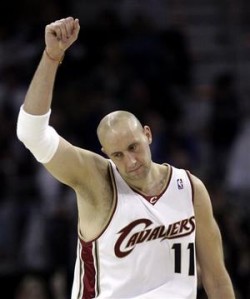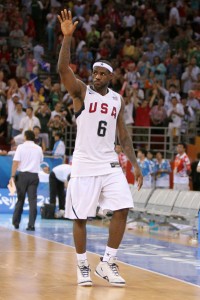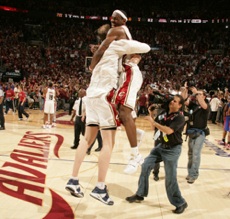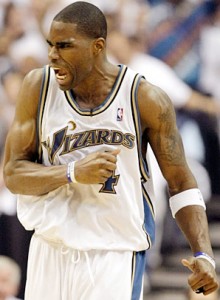LeBron James had 30 points, eight rebounds, seven assists, three blocked shots and two steals as the Cleveland Cavaliers beat the Boston Celtics 104-93. Although James was highly productive, he had plenty of help, too: Anderson Varejao contributed 17 points and 10 rebounds off of the bench, Antawn Jamison added 15 points and 12 rebounds and Mo Williams scored 14 points with six assists. Ray Allen overcame a slow start to lead the Celtics with 20 points plus six rebounds and five assists, while Paul Pierce also struggled early in the game before finishing with 18 points, four assists and three rebounds. Kevin Garnett, seems to be playing on about one and a half legs in the wake of last year’s knee injury, added 18 points and seven rebounds but this season his trash talking bark has definitely been much worse than his productivity bite, which is a major reason that the Celtics are not as good as they were when they won the 2008 NBA Championship.
Although the final victory margin was not huge, this was a very impressive win for the Cavs considering the fact that they outscored the Celtics 44-34 in the paint and won the rebounding battle 51-43 despite being without Zydrunas Ilgauskas–who the Cavs can re-sign in a week–and the injured Shaquille O’Neal. I have touted the Cavs as the best team in the East throughout the season but I thought that with both O’Neal and Ilgauskas out of action the Cavs might be vulnerable inside against certain teams but that has not proven to be the case: the Cavs are now 9-4 since trading Ilgauskas for Antawn Jamison, including 7-1 since O’Neal got hurt. The Cavs lost three straight games right after the trade–ending a 13 game winning streak–but the coaching staff successfully made the appropriate adjustments, the new rotation meshed and the Cavs quickly resumed being a strong defensive team that is also quite potent offensively. NBA odds listed the Cavaliers as 6.5-point favorites at home against the Celtics.
The Cavs are still the only team that has clinched a playoff berth in either conference, they are 5.5 games ahead of the Orlando Magic in the race for the top seed in the East and they are 3.5 games ahead of the L.A. Lakers in the race for the best overall record (the Cavs own the tiebreaker over the Lakers by virtue of sweeping the season series 2-0 and they have a 2-1 edge over the Magic with one head to head game remaining). If the Cavs go just 10-5 the rest of the way they will own homecourt advantage throughout the playoffs no matter what–and each loss by the Magic and Lakers reduces the Cavs’ “magic number.”
This game included several interesting subplots:
1) James only scored six first half points yet the Cavs led 54-48 after 24 minutes (and they would have been up nine if Paul Pierce had not stumbled his way into convincing the referees that he had been fouled while attempting a buzzer beating three pointer); James did have an excellent floor game in the first half (six assists and four rebounds). When Kobe Bryant has a half like that and the L.A. Lakers are leading, the TV commentators tend to say two things: Bryant is not shooting to “prove a point” and the fact that the Lakers are winning anyway shows just how deep their team is. I know from personal experience that Bryant or James both have the same answer if you ask about their shooting/passing decisions: they read what the defense is giving and make the appropriate decision to shoot, drive or pass. For the most part, I believe both of them, though it is obvious in certain situations that Bryant and James can also force the defense to “give” them something as opposed to just reading and reacting. It just seems strange that Bryant is both criticized for supposedly shooting too much and for sometimes supposedly deliberately not shooting, while the default media position is generally to not question James’ shot selection (with a few exceptions, most notably the 2007 playoff game versus Detroit when James passed to Donyell Marshall in the final seconds instead of shooting the ball himself). The truth is that both Bryant and James are exceptional decision makers and they generally do whatever is in the best interests of their respective teams; they both force shots at times–a statement which is true of just about every player in league history who ever averaged 28-30 or more ppg in a season–but their positive contributions more than offset their occasional bad shots, particularly considering that some of their bad shots connect anyway!
2) It is just bizarre that throughout the telecast very little mention was made of the absence of O’Neal and Ilgauskas, particularly in light of that first half when James hardly scored and yet the Cavs controlled the paint. Very few–if any–NBA teams could withstand the loss of two quality seven footers who collectively average 19.5 ppg and 12.0 rpg; that is a lot of size and production, yet the Cavs have not missed a beat, simply plugging other players into those roles while giving minutes to some players who previously were not even in the rotation at all. This vividly validates what I have been saying all along about Cleveland’s incredible depth and that depth has been further augmented by the Jamison acquisition. Cleveland’s depth was the main story of this game and yet it was treated as a side story at best.
3) Check out the 2009-10 statistics of two players:
Player A is averaging 30.8 mpg, 10.2 ppg, 9.6 rpg, 3.4 apg, .7 bpg, .9 spg and 1.8 to/g while shooting .458 from the field, .306 from three point range and .696 from the free throw line.
Player B is averaging 29.1 mpg, 8.8 ppg, 7.9 rpg, 1.1 apg, .9 bpg, .9 spg and 1.0 to/g while shooting .565 from the field, .200 from three point range and .669 from the free throw line.
Players cannot be correctly evaluated just by looking at their numbers without considering their skill sets and roles but it seems evident that the two players in question are roughly equal: Player A’s advantages in some categories are offset by the huge difference in field goal percentage. Player A is often described as an All-Star caliber performer who is perhaps the best sixth man in the league, while Player B is often dismissed as someone who is a limited role player. In case you have not figured it out by now, Player A is Lamar Odom, while Player B is Anderson Varejao. Odom may be the Lakers’ second best playmaker but that is more of an indictment of their point guard situation than anything else: starting point guard Derek Fisher is an aging spot up shooter, not a penetrating creator, while backups Jordan Farmar and Shannon Brown are not true point guards and have displayed little ability to create shots for others (not to mention questionable shot selection). While the Lakers depend heavily on Bryant (and the Triangle Offense) to create shots for his teammates, the Cavs have at least four players who can create shots for others (LeBron James, Mo Williams, Delonte West and Anthony Parker, who played some point guard for Toronto), so they don’t need or want Varejao to be handling the ball out front. The reality is that despite the hype, Varejao is currently at least as good as Odom and I would actually take Varejao over Odom because Varejao more consistently plays with energy/effort and he is an excellent defender at both the center and power forward positions, while Odom’s energy/effort are much less consistent and his defense can be very good at times but is often lethargic.
Varejao is a major reason why the Cavs have been able to survive without O’Neal and Ilgauskas; he is rebounding, defending and even showing that he can handle an expanded scoring role without a corresponding reduction in his field goal percentage–and that should not be taken for granted, as Houston is finding out this year with Trevor Ariza.
4) The halftime show included a segment about how Garnett consistently goaltends shots during play stoppages so that opposing players do not have the satisfaction of seeing the ball go through the hoop. This is supposedly a great contribution that Garnett makes toward winning even though it obviously does not count in the boxscore. Another way to refer to this is “wasted energy”; when I see Garnett skying to block shots that would not have counted anyway the first thing that I think of is a young Dominique Wilkins working up a game sweat during warmups by doing all kinds of fancy dunks, thus expending energy that could have been more profitably used during the 35-40 minutes he played that actually mattered. Then I think of Jim Brown, arguably the greatest pro football player ever, and the way that he conserved energy by getting up slowly after each pileup only to go at full speed once play resumed. I find it hard to believe that any quality player would truly be psyched out by Garnett’s antics; this would be irritating at first, perhaps, as Reggie Miller and Vince Carter stated during the halftime piece, but then it would just be humorous. Garnett deserves full credit for being the defensive anchor for the 2008 championship team but let’s not forget that he did not have to do much offensively for that Boston squad because he had two Hall of Famers in Paul Pierce and Ray Allen to handle the crunch time scoring duties; Garnett’s extracurricular blocks produced very little postseason glory when he was his team’s primary scoring option in Minnesota, so why act like they are the secret behind Boston’s success? When Garnett was fully healthy, he contributed rebounding, defensive range/length, solid screens (including some of the “best” moving screens that were not called as such), decent ball reversals from the high post and just enough midrange jumpers/turnaround fadeaway jumpers to keep defenses honest; those things meant much more than fake blocked shots. Furthermore, let’s not forget that despite his prodigious length and athleticism Garnett was never a great shotblocker: he has only ranked in the top ten in that category once in 15 seasons and he has only averaged more than 2 bpg twice, topping out at 2.2 bpg in 2003-04. In contrast, Tim Duncan–who has always been a far less explosive leaper than Garnett–averaged at least 2 bpg in each of his first 10 seasons and he has ranked in the top ten in that category 10 times.
Instead of rhapsodizing about Garnett swatting shots that would not have counted anyway it would have been much more informative–and relevant–to discuss Cleveland’s frontcourt depth and to explain why an active, energetic and efficient player like Varejao is in fact more valuable than the highly touted Odom. Sadly, though, that kind of intelligent NBA analysis is well beyond the capabilities of many of the people who talk and write about the game, so what we are left with is talking heads spewing hot air and “highlights” of blocked shots that were about as meaningful as a mascot dunking after jumping off of a trampoline.
 Zydrunas Ilgauskas is expected to sign a one year deal to play with the Cleveland Cavaliers the rest of the season The Cleveland Plain Dealer reported this morning. Zydrunas wanted to get a deal done as soon as possible so he can travel with the team in their upcoming road trip to New Orleans and San Antonio according to his agent Herb Rudoy.
Zydrunas Ilgauskas is expected to sign a one year deal to play with the Cleveland Cavaliers the rest of the season The Cleveland Plain Dealer reported this morning. Zydrunas wanted to get a deal done as soon as possible so he can travel with the team in their upcoming road trip to New Orleans and San Antonio according to his agent Herb Rudoy. Lebron James filed paper work yesterday to officially change his jersey number to No. 6 from his current No.23, the Cleveland Plain Dealer reported on Monday.
Lebron James filed paper work yesterday to officially change his jersey number to No. 6 from his current No.23, the Cleveland Plain Dealer reported on Monday. The Washington Wizards and Zydrunas Ilgauskas have reached an agreement on a contract buyout according to the The Washington Post.
The Washington Wizards and Zydrunas Ilgauskas have reached an agreement on a contract buyout according to the The Washington Post. Cleveland, Washington and the Los Angeles Clippers have agreed to a three-team deal that will bring Antawn Jamison to the Cavalier.
Cleveland, Washington and the Los Angeles Clippers have agreed to a three-team deal that will bring Antawn Jamison to the Cavalier.